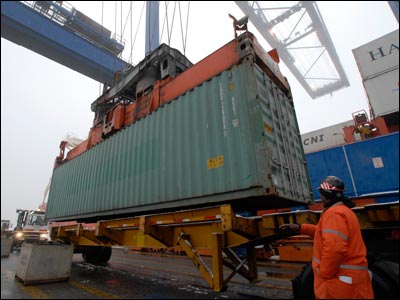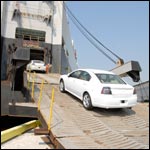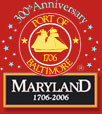
|
Think about it this way … When you travel you pack your clothes in a suitcase. It has a handle to make it easier to carry. It may have wheels to roll it from place to place. The handles retract to keep them from getting caught in the baggage handler at the airport. All of this makes it easier to move your clothes, shoes and other belongings. But if you are taking the family dog with you to grandma’s house for the holidays, it will probably walk beside you on leash to the car. The large animal is more easily lead than packed and carried. How is this like container cargo and roll on/roll off cargo? |
||
 |
 On April 26, 1956, Malcom McLean’s ship, the SS Ideal-X, was loaded with 58 35-foot containers and other cargo and sailed off into history. McLean had hit upon the idea of putting cargo into containers as he watched a crew laboriously load a ship with crates of goods one day. Each crate had to be hoisted up and into the ship. McLean realized it would be easier to simply remove the trailer off the back of a truck and load it into the ship. Others had experimented with similar ideas, but the SS Ideal_X was the first ship to use containers that remained closed as they were being transferred back and forth between ships, trucks and railways.
On April 26, 1956, Malcom McLean’s ship, the SS Ideal-X, was loaded with 58 35-foot containers and other cargo and sailed off into history. McLean had hit upon the idea of putting cargo into containers as he watched a crew laboriously load a ship with crates of goods one day. Each crate had to be hoisted up and into the ship. McLean realized it would be easier to simply remove the trailer off the back of a truck and load it into the ship. Others had experimented with similar ideas, but the SS Ideal_X was the first ship to use containers that remained closed as they were being transferred back and forth between ships, trucks and railways.
The savings of using containers was incredible. In 1956, it cost $5.86 per ton to load a ship by hand. But it only cost 16 cents a ton using McLean’s containers.
The Port Ranks at the Top …
In the most recent national ranking of all the ports in the U.S. (361), the Helen Delich Bentley Port of Baltimore is:
Number one in the nation for …
- Roll on/Roll off cargo (farm and construction equipment),
- Imported forest products,
- Exported autos,
- Imported sugar, and
- Gypsum and iron ore.
Number two in the nation for …
- Automobiles (combined imports and exports).,
Number three in the nation for …
- Imported aluminum, and
- Exported coal.
Overall, the Port of Baltimore is ranked 12th nationally for total dollar value of cargo and 13th for total cargo tonnage handled.
Ro/Ro and containerized cargo
Technology Makes
the Job Easier
The Port of Baltimore has a real edge on its competition, mainly because of its technological advances and quality service in handling all kinds of cargo.
TYPES OF CARGO
Containerized shipping
In the past, people would have to hand-pack ships, offload all the packages, move them to trucks, wagons, or even rail cars, and unpack them again when they got to market. And every time cargo is moved, it can become lost or damaged.
These concerns are eliminated with containerized shipping. Goods are placed in a container of a standard size. Then, the containers are loaded onto ships, from where they can be offloaded quickly onto trucks or railroad cars. Since the cargo is packed only once, and only touched by the packers and the customer, it significantly reduces the chance it can be lost, damaged, or otherwise harmed.
Roll On/Roll Off (Ro/Ro)
Once, it was long, hard work to ship cargoes such as huge farm machines. Batteries had to be disconnected and gas tanks emptied. Then, they had to be hauled, one by one, onto a ship.
But all these problems are solved with specialized ship design. Combines, hay balers and the like are driven on and off of specially-designed ships without any extra preparation. These ships are based on the same design principle as ferries. Typically, the ships have ramps on their sides and stern (back of the boat) that can be attached to piers, allowing the machines to be driven to and from piers when the ships have reached their destination.
Break and Break Bulk Cargo
Cargo that is not placed in a container or driven onto a ship is called break, or break-bulk cargo. Break-bulk cargo is typically stored in boxes, bales, or other units and then transferred to and from ships. Bulk cargo is loose dry or liquid cargo, such as grain, coal, and oil.
The Port of Baltimore is the number one Ro/Ro port in the U.S., handling over 50 percent of the Ro/Ro cargo that comes into east coast. Besides having the latest technology to handle these kinds of cargo, the Port promises to have the lowest damage rate of any port in the country. And it meets this goal year after year, thanks to its Quality Cargo Handling Action Team (QCHAT) for Ro/Ro. The Port also assures continued quality service for its customers through its annual Ro/Ro Rodeo, where Port workers receive training in operating and maneuvering the many different vehicles that come through the Port as Ro/Ro cargo. The Rodeo is the only one of its kind in the nation.
Because of facilities like Seagirt Marine Terminal and Dundalk Marine Terminal, Baltimore is also the 13th largest container port in the United States. More than sixty percent of the cargo that passes through the Port is containerized. These containers carry everything from clothing and furniture to steel and electronics. In 2006, the Port handled 627,951 containers.




